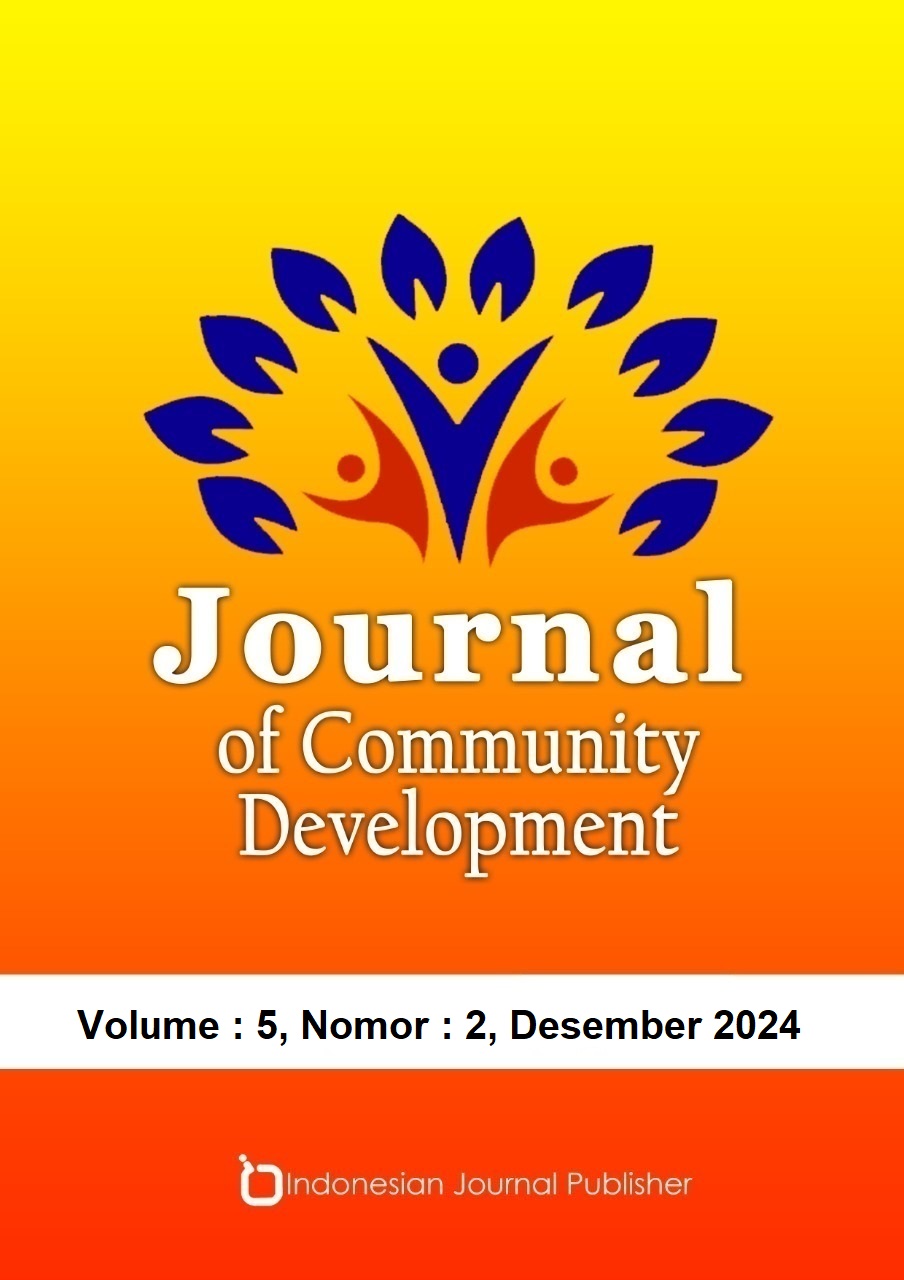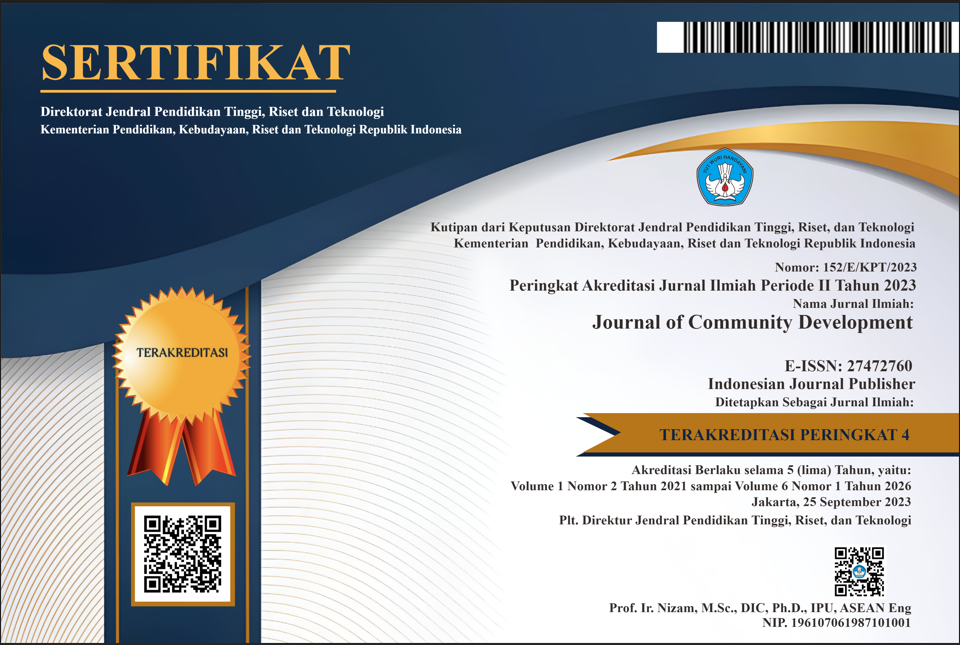Simulasi Penatalaksanaan Kegawatdaruratan Bencana Banjir pada Masyarakat di Desa Panti Kecamatan Panti Kabupaten Jember
DOI:
https://doi.org/10.47134/comdev.v5i2.262Keywords:
Disaster preparedness, Mitigation, NurseAbstract
Natural and non-natural disasters occurring in the world continue to increase unpredictably. Considering that disasters can occur at any time, community preparedness in facing disasters is very important. However, the research results show that community preparedness still needs to be improved. This condition also occurs with service partners. Even though Panti Village area is a disaster-prone area, public awareness of disaster preparedness is still low. However, on the other hand, partners have the potential to be developed, namely the existence of Disaster Preparedness Village Youth (DESTANA) which is expected to become a driving force to increase public awareness of disaster preparedness. The solution offered to overcome this problem is to increase community awareness and ability to prepare for disasters through collaboration with DESTANA and BPBD. The activities carried out include health education about disaster management and continued with simulations of disaster emergency management such as the evacuation process when a disaster occurs, dressing splints and simple wound care when a disaster occurs, as well as planting trees as a reforestation effort to prevent flooding. The results show that public knowledge about disaster management increased after being given health education to 77.8% and the remaining 22.2% had fairly good knowledge. After the simulation, the community's skills in evacuating disaster victims became better (82.2% had good skills). Community skills increased by 48.9% of people were able to do simple splint dressing after the simulation. After being given a wound care simulation, people's skills increased by 40% to become skilled at carrying out wound care. Health education and disaster management simulations need to be provided regularly by health workers through collaboration with DESTANA as a disaster prevention mitigation effort.
Downloads
References
Adriani, S.W, Anggraeni, Z.E., Hidayat, N.M., et al. (2022) ‘Analisis Potensi Kesiapsiagaan Masyarakat dalam Menghadapi Bencana Banjir’, Jurnal Keperawatan Muhammadiyah, 7(4), pp. 45–51.
Adriani, S.W, Anggraeni, Z.E., Aprilia, N.C., et al. (2022) ‘Pemberdayaan Destana dalam Mengembangkan Desa Siaga Bencana Berbasis Masyarakat’, MARTABE: Jurnal Pengabdian Kepada Masyarakat, 5(6), pp. 2018–2024.
Adriani, Sri Wahyuni et al. (2022) ‘POTENSI DESA SIAGA BENCANA BERBASIS MASYARAKAT. 5, pp. 2018–2024.
Anam, K., Hidayatullah, M.R. and Evitamala, L. (2022) ‘Disaster Mitigation Trainig in Safe Education’, Abdinesia: Jurnal Pengabdian Kepada Masyarakat, 2(1 Februari), pp. 15–18.
Astuti, L.P., Hidayat, W. and Tarigan, F.L. (2022) ‘Kesiapsiagaan Petugas Kesehatan dalam Manajemen Bencana Banjir Bandang di Kecamatan kebayakan Kabupaten Aceh Tengah’, Bina Generasi; Jurnal Kesehatan, 14(1), pp. 54–63.
Bhadra, M.R., Mujibuddaula Sardar Kanak, N.N.M. and Islam, R. (2012) ‘Empowering communities to cope with disaster risks through community based disaster management’, Proceedings of the 4th International Disaster and Risk Conference: Integrative Risk Management in a Changing World - Pathways to a Resilient Society, IDRC Davos 2012, pp. 80–84.
BPBD Kabupaten Jember (2013) Data badan penanggulangan bencana daerah. Available at: https://ppid.jemberkab.go.id/.
Diyana, et. al (2020) ‘Community preparedness to flood disaster in Johor , Malaysia’. Available at: https://doi.org/10.1088/1755-1315/479/1/012015.
Hutagaol, E.K. (2019) ‘HEALTH PROBLEMS IN DISASTER CONDITIONS: ROLE OF COMMUNITY PARTICIPATION HEALTH OFFICERS’, Jurnal Ilmiah Kesehatan Institut Medika drg.Suherman, 1(1).
Jieun, L. and Eunjoo, L. (2020) ‘The Effects of Disaster Training Education on the Attitudes, Preparedness, and Competencies in Disaster Nursing of Hospital Nurses’, Journal of Korean Academy of Community Health Nursing, 31(4), pp. 491–502. Available at: https://doi.org/10.12799/JKACHN.2020.31.4.491.
Linda, A.L., Adriani, S.W. and Hidayat, C.T. (2022) ‘Faktor yang Mempengaruhi Kesiapan Masyarakat dalam Menghadapi Bencana Tanah Longsor di Desa Mulyorejo, Jember’, JIK JURNAL ILMU KESEHATAN, 6(2), p. 508. Available at: https://doi.org/10.33757/jik.v6i2.556.
Wahyuni Adriani, S. et al. (no date) ‘PENINGKATAN KAPABILITAS MASYARAKAT DALAM PENANGGULANGAN BENCANA BERBASIS TEKNOLOGI MELALUI PELATIHAN BANTUAN HIDUP DASAR’. Available at: https://doi.org/10.31604/jpm.v6i5.1689-1695.
Widayatun & Fatoni, Z. (2013) ‘Health Problems in a Disaster Situation: The Role of Health Personnels and Community Participation’, Jurnal Kependudukan Indonesia, 8(1), pp. 37–52.
Downloads
Published
How to Cite
Issue
Section
Categories
License
Copyright (c) 2024 Sri Wahyuni Adriani, Cipto Susilo, Indah Pandari, Hafni Ainun Arif Kurniansyah

This work is licensed under a Creative Commons Attribution 4.0 International License.







